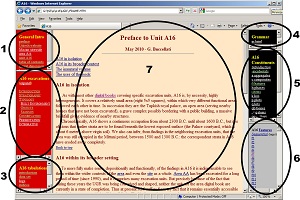Back to top: Preface to Unit [A16](https://urkesh.org/mz/a/A16/ugr/-frame.htm)
A16 in isolation
As with most other digital books covering specific excavation units, A16 is, by necessity, highly heterogeneous. It covers a relatively small area (eight 5x5 squares), within which very different functional areas followed each other in time. In succession they are: the Tupkish royal palace, an open area (serving nearby houses that have not been excavated), a grave complex possibly bordering with a public building, a massive brickfall giving evidence of nearby structures.
Chronologically, A16 shows a continuous occupation from about 2300 B.C. until about 1600 B.C., but it is obvious that earlier strata are to be found beneath the lowest exposed surface (the Palace courtyard, which is about 6 meters above virgin soil). We also can infer, from findings in the neighboring excavation units, that the area was still occupied in the Mittani period, between 1500 and 1300 B.C.: the correspondent strata in A16 have eroded away completely.
Back to top: Preface to Unit [A16](https://urkesh.org/mz/a/A16/ugr/-frame.htm)
A16 within its broader setting
To more fully make sense, depositionally and functionally, of the findings in [A16]A16 it is indispensable to see them within the wider contexts of the area and even the site as a whole. Area AA has been excavated for a long period of time (since 1990), and it comprises many excavation units. But precisely because of the fact that during these years the UGR was being conceived and shaped, neither the unit nor the area digital book are currently in a state of completion. Thus at present A16 suffers from the fact that it remains essentially accessible in a relative vacuum – which will hopefully be filled in the coming years as the entire record is published.
Back to top: Preface to Unit [A16](https://urkesh.org/mz/a/A16/ugr/-frame.htm)
The inaugural volume
A16 was the inaugural volume of the UGR system, and, as such, it has served as the standard point of reference for all subsequent digital books. Not that it was completed at the end of the excavation season, nor soon after that (see the cronicle for details). In fact, it has remained in the works ever since, as the research progressed and the UGR was refined. But it remained throughout the model, not only for the structure of the analytical part (accessed from the right hand side vertical bar), but also for that of the synthetic part and of the tabulations, as with the treatment of the objects (especially the ceramics and the glyptics) or the conservation lab. The tabulations of the ceramics, for a total of 61,082 pieces, were the first to be completed and served as the test data for the respective programs (see for example the frequencies by wares or by feature).
Back to top: Preface to Unit [A16](https://urkesh.org/mz/a/A16/ugr/-frame.htm)
The uses of the book
To be able to “read” the A16 digital book, like any other such book, requires a certain familiarity with its structure, although the intent has been to make access to the browser edition as transparent as possible. One will find a detailed explanation of the page layout in the Mozan Sitewide digital book.
You can find an explanation of the broader concept of a digital publication in the Global Record section of the Urkesh website, and a discussion of the even wider implications of digital thought in the corresponding digital monograph of the Methodology section of the Urkesh website.
Briefly:
|

|
Back to top: Preface to Unit [A16](https://urkesh.org/mz/a/A16/ugr/-frame.htm)